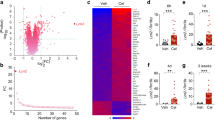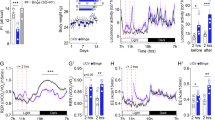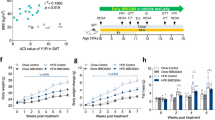Abstract
The endocannabinoid system has recently emerged as an important regulator of energy homeostasis, involved in the control of both appetite and peripheral fat metabolism. We briefly review current understanding of the possible sites of action and cellular mechanisms involved in the central appetitive and peripheral metabolic effects of endocannabinoids. Studies in our laboratory, using leptin-deficient obese rodents and CB1 cannabinoid receptor (CB1)-deficient mice, have indicated that endocannabinoids acting via CB1 are involved in the hunger-induced increase in food intake and are negatively regulated by leptin in brain areas involved in appetite control, including the hypothalamus, limbic forebrain and amygdala. CB1−/− mice are lean and are resistant to diet-induced obesity (DIO) despite similar energy intake to wild-type mice with DIO, suggesting that CB1 regulation of body weight involves additional peripheral targets. Such targets appear to include both adipose tissue and the liver. CB1 expressed in adipocytes has been implicated in the control of adiponectin secretion and lipoprotein lipase activity. Recent findings indicate that both endocannabinoids and CB1 are present in the liver and are upregulated in DIO. CB1 stimulation increases de novo hepatic lipogenesis through activation of the fatty acid biosynthetic pathway. Components of this pathway are also expressed in the hypothalamus where they have been implicated in the regulation of appetite. The fatty acid biosynthetic pathway may thus represent a common molecular target for the central appetitive and peripheral metabolic effects of endocannabinoids.
This is a preview of subscription content, access via your institution
Access options
Subscribe to this journal
Receive 12 print issues and online access
$259.00 per year
only $21.58 per issue
Buy this article
- Purchase on Springer Link
- Instant access to full article PDF
Prices may be subject to local taxes which are calculated during checkout


Similar content being viewed by others
References
Abel EL . Effects of marijuana on the solution of anagrams, memory and appetite. Nature 1971; 231: 260–261.
Devane WA, Hanus L, Breuer A, Pertwee RG, Stevenson LA, Griffin G et al. Isolation and structure of a brain constituent that binds to the cannabinoid receptor. Science 1992; 258: 1946–1949.
Sugiura T, Kondo S, Sukagawa A, Nakane S, Shinoda A, Itoh K et al. 2-Arachidonoylglycerol: a possible endogenous cannabinoid receptor ligand in brain. Biochem Biophys Res Commun 1995; 215: 89–97.
Mechoulam R, Ben Shabat S, Hanus L, Ligumsky M, Kaminski NE, Schatz AR et al. Identification of an endogenous 2-monoglyceride, present in canine gut, that binds to cannabinoid receptors. Biochem Pharmacol 1995; 50: 83–90.
Sharkey KA, Pittman QJ . Central and peripheral signaling mechanisms involved in endocannabinoid regulation of feeding: a perspective on the munchies. Sci STKE 2005; 277: pe15.
Di Marzo V, Matias I . Endocannabinoid control of food intake and energy balance. Nat Neurosci 2005; 8: 585–589.
Pagotto U, Marsicano G, Cota D, Lutz B, Pasquali R . The emerging role of the endocannabinoid system in endocrine regulation and energy balance. Endocr Rev 2006; 27: 73–100.
Rinaldi-Carmona M, Barth F, Heaulme M, Shire D, Calandra B, Congy C et al. SR141716A, a potent and selective antagonist of the brain cannabinoid receptor. FEBS Lett 1994; 350: 240–244.
Rinaldi-Carmona M, Barth F, Millan J, Derocq JM, Casellas P, Congy C et al. SR 144528, the first potent and selective antagonist of the CB2 cannabinoid receptor. J Pharmacol Exp Ther 1998; 284: 644–650.
Matsuda LA, Lolait SJ, Brownstein MJ, Young AC, Bonner TI . Structure of a cannabinoid receptor and functional expression of the cloned cDNA. Nature 1990; 346: 561–564.
Palmer SL, Thakur GA, Makriyannis A . Cannabinergic ligands. Chem Phys Lipids 2002; 121: 3–19.
Munro S, Thomas KL, Abu-Shaar M . Molecular characterization of a peripheral receptor for cannabinoids. Nature 1993; 365: 61–65.
Colombo G, Agabio R, Diaz G, Lobina C, Reali R, Gessa GL . Appetite suppression and weight loss after the cannabinoid antagonist SR 141716. Life Sci 1998; 63: PL113–PL117.
Simiand J, Keane M, Keane PE, Soubrie P . SR 141716, a CB1 cannabinoid receptor antagonist, selectively reduces sweet food intake in marmoset. Behav Pharmacol 1998; 9: 179–181.
Freedland CS, Poston JS, Porrino LJ . Effects of Sr141716A, a central cannabinoid receptor antagonist, on food-maintained responding. Pharmacol Biochem Behav 2000; 67: 265–270.
Williams CM, Kirkham TC . Anandamide induces overeating: mediation by central cannabinoid (CB1) receptors. Psychopharmcology 1999; 143: 315–317.
Hao S, Avraham Y, Mechoulam R, Berry EM . Low dose anandamide affects food intake, cognitive function, neurotransmitter and corticosterone levels in diet-restricted mice. Eur J Pharmacol 2000; 392: 147–156.
Kirkham TC, Williams CM, Fezza F, Di Marzo V . Endocannabinoid levels in rat limbic forebrain and hypothalamus in relation to fasting, feeding and satiation: stimulation of eating by 2-arachidonoyl glycerol. Br J Pharmacol 2002; 136: 550–557.
Gifford AN, Ashby Jr CR . Electrically evoked acetylcholine release from hippocampal slices is inhibited by the cannabinoid receptor agonist, WIN 55212-2, and is potentiated by the cannabinoid antagonist, SR 141716A. J Pharmacol Exp Ther 1996; 277: 1431–1436.
Bouaboula M, Perrachon S, Milligan L, Canat X, Rinaldi-Carmona M, Portier M et al. A selective inverse agonist for central cannabinoid receptor inhibits mitogen-activated protein kinase activation stimulated by insulin or insulin-like growth factor 1. Evidence for a new model of receptor/ligand interactions. J Biol Chem 1997; 272: 22330–22339.
Zimmer A, Zimmer AM, Hohmann AG, Herkenham M, Bonner TI . Increased mortality, hypoactivity, and hypoalgesia in cannabinoid CB1 receptor knockout mice. Proc Natl Acad Sci USA 1999; 96: 5780–5785.
Di Marzo V, Goparaju SK, Wang L, Liu J, Batkai S, Jarai Z et al. Leptin-regulated endocannabinoids are involved in maintaining food intake. Nature 2001; 410: 822–825.
Kunos G, Osei-Hyiaman D, Wang L, Liu J, Batkai S . Endocannabinods: novel lipid mediators involved in the neural control of appetite. In: Medeiros-Neto S, Halpern A, Bouchard C (eds). Progress in Obesity Research. John Libby Eurotext, Surrey, UK, 2002. pp 826–828.
Jamshidi N, Taylor DA . Anandamide administration into the ventromedial hypothalamus stimulates appetite in rats. Br J Pharmacol 2001; 134: 1151–1154.
Hanus L, Avraham Y, Ben-Shushan D, Zolotarev O, Berry EM, Mechoulam R . Short-term fasting and prolonged semistarvation have opposite effects on 2-AG levels in mouse brain. Brain Res 2003; 983: 144–151.
Freedland CS, Whitlow CT, Smith HR, Porrino LJ . Functional consequences of the acute administration of the cannabinoid receptor antagonist, SR141716A, in cannabinoid-naive and -tolerant animals: a quantitative 2-[14C]deoxyglucose study. Brain Res 2003; 962: 169–179.
Cota D, Marsicano G, Tschop M, Grubler Y, Flachskamm C, Schubert M et al. The endogenous cannabinoid system affects energy balance via central orexigenic drive and peripheral lipogenesis. J Clin Invest 2003; 112: 423–431.
Iqbal J, Pompolo S, Murakami T, Grouzmann E, Sakurai T, Meister B et al. Immunohistochemical characterization of localization of long-form leptin receptor (OB-Rb) in neurochemically defined cells in the ovine hypothalamus. Brain Res 2001; 920: 55–64.
Hübschle T, Thom E, Watson A, Roth J, Klaus S, meyerhof W . Leptin-induced nuclear translocation of STAT3 immunoreactivity in hypothalamic nuclei involved in body weight regulation. J Neurosci 2001; 21: 2413–2424.
Fadel J, Deutch AY . Anatomical substrates of orexin-dopamine interactions: lateral hypothalamic projections to the ventral tegmental area. Neuroscience 2002; 111: 379–387.
Gomez R, Navarro M, Ferrer B, Trigo JM, Bilbao A, Del Arco I et al. A peripheral mechanism for CB1 cannabinoid receptor-dependent modulation of feeding. J Neurosci 2002; 22: 9612–9617.
Burdyga G, Lal S, Varro A, Dimaline R, Thompson DG, Dockray DG . Expression of cannabinoid CB1 receptors by vagal afferent neurons is inhibited by cholecystokinin. J Neurosci 2004; 24: 2708–2715.
Gardner EL . Addictive potential of cannabinoids: the underlying neurobiology. Chem Phys Lipids 2002; 121: 267–290.
Higgs S, Williams CM, Kirkham TC . Cannabinoid influences on palatability: microstructural analysis of sucrose drinking after delta(9)-tetrahydrocannabinol, anandamide, 2-arachidonoyl glycerol and SR141716. Psychopharmacology 2003; 165: 370–377.
Harrold JA, Elliott JC, King PJ, Widdowson PS, Williams G . Down-regulation of cannabinoid-1 (CB-1) receptors in specific extrahypothalamic regions of rats with dietary obesity: a role for endogenous cannabinoids in driving appetite for palatable food? Brain Res 2002; 952: 232–238.
Miller CC, Murray TF, Freeman KG, Edwards GL . Cannabinoid agonist, CP 55,940, facilitates intake of palatable foods when injected into the hindbrain. Physiol Behav 2004; 80: 611–616.
Saper CB . The central autonomic nervous system: conscious visceral perception and autonomic pattern generation. Annu Rev Neurosci 2002; 25: 433–469.
Seeley RJ, Yagaloff KA, Fisher SL, Burn P, Thiele TE, van Dijk G et al. Melanocortin receptors in leptin effects. Nature 1997; 390: 349.
Stephens TW, Basinski M, Bristow PK, Bue-Valleskey JM, Burgett SG, Craft L et al. The role of neuropeptide Y in the antiobesity action of the obese gene product. Nature 1995; 377: 530–532.
Seeley RJ, Woods SC . Monitoring of stored and available fuel by the cNS: implications for obesity. Nat Neurosci 2003; 4: 901–909.
Cohen P, Miyazaki M, Socci ND, Hagge-Greenberg A, Liedtke W, Soukas AA et al. Role for stearoyl-CoA desaturase-1 in leptin-mediated weight loss. Science 2002; 297: 240–243.
Ravinet Trillou C, Arnone M, Delgorge C, Gonalons N, Keane P, Maffrand JP et al. Anti-obesity effect of SR141716, a CB1 receptor antagonist, in diet-induced obese mice. Am J Physiol Regul Integr Comp Physiol 2003; 284: R345–R353.
Ravinet Trillou C, Delgorge C, Menet C, Arnone M, Soubrie P . CB1 cannabinoid receptor knockout in mice leads to leanness, resistance to diet-induced obesity and enhanced leptin sensitivity. Int J Obes Relat Metab Disord 2004; 28: 640–648.
Osei-Hyiaman D, DePetrillo M, Pacher P, Liu J, Radaeva S, Batkai S et al. Endocannabinoid activation at hepatic CB1 receptors stimulates fatty acid synthesis and contributes to diet-induced obesity. J Clin Invest 2005; 115: 1298–1305.
Bensaid M, Gary-Bobo M, Esclangon A, Maffrand JP, Le Fur G, Oury-Donat F et al. The cannabinoid CB1 receptor antagonist SR141716 increases Acrp30 mRNA expression in adipose tissue of obese fa/fa rats and in cultured adipocyte cells. Mol Pharmacol 2003; 63: 908–914.
Diraison F, Yankah V, Letexier D, Dusserre E, Jones P, Beylot M . Differences in the regulation of adipose tissue and liver lipogenesis by carbohydrates in humans. J Lipid Res 2003; 44: 846–853.
Brown MS, Goldstein JL . Sterol regulatory element binding proteins (SREBPs): controllers of lipid synthesis and cellular uptake. Nutr Rev 1998; 56: S1–S3.
Porcella A, Marchese G, Casu MA, Rocchitta A, Lai LM . Evidence for functional CB1 cannabinoid receptor expressed in the rat thyroid. Eur J Endocrinol 2002; 147: 255–261.
Siegmund SV, Uchinami H, Osawa Y, Brenner DA, Schwabe RF . Anandamide induces necrosis in primary hepatic stellate cells. Hepatology 2005; 41: 1085–1095.
Michalopoulos GK, Bowen WC, Kule K, Luo J . HGF-, EGF-, and dexamethasone-induced gene expression patterns during formation of tissue in hepatic organoid cultures. Gene Expression 2003; 11: 55–75.
Hu CC, Qing K, Chen Y . Diet-induced chages in stearoyl-CoA desaturase 1 expression in obesity-prone and -resistant mice. Obes Res 2004; 12: 1264–1270.
Yamauchi T, Kamon J, Minokoshi Y, Ito Y, Waki H, Uchida S et al. Adiponectin stimulates glucose utilization and fatty-acid oxidation by activating AMP-activated protein kinase. Nat Med 2002; 8: 1288–1295.
Obici S, Feng Z, Arduini A, Conti R, Rossetti R . Inhibition of hypothalamic carnitine palmitoyltransferase-1 decreases food intake and glucose production. Nat Med 2003; 9: 756–761.
Kim EK, Miller I, Aja S, Landree LE, Pinn M, McFadden J et al. C75, a fatty acid synthase inhibitor, reduces food intake via hypothalamic AMP-activated protein kinase. J Biol Chem 2004; 279: 19970–19976.
Paulaskis JD, Sul HS . Cloning and expression of mouse fatty acid synthase and other specific mRNA. Developmental and hormonal regulation in 3T3-L1 cells. J Biol Chem 1988; 263: 7049–7054.
Minokoshi Y, Alquier T, Furakawa N, Kim YB, Lee A, Xue B et al. AMP-kinase regulates food intake by responding to hormonal and nutrient signals in the hypothalamus. Nature 2004; 428: 569–574.
Kola B, Hubina E, Tucci SA, Kirkham TC, Garcia EA, Mitchell SE et al. Cannabinoids and ghrelin have both central and peripheral metabolic and cardiac effects via AMP-activated kinase. J Biol Chem 2005; 280: 25196–25201.
Author information
Authors and Affiliations
Corresponding author
Rights and permissions
About this article
Cite this article
Osei-Hyiaman, D., Harvey-White, J., Bátkai, S. et al. The role of the endocannabinoid system in the control of energy homeostasis. Int J Obes 30 (Suppl 1), S33–S38 (2006). https://doi.org/10.1038/sj.ijo.0803276
Published:
Issue Date:
DOI: https://doi.org/10.1038/sj.ijo.0803276
Keywords
This article is cited by
-
A pilot exploration of multi-omics research of gut microbiome in major depressive disorders
Translational Psychiatry (2022)
-
Endocannabinoid signaling of homeostatic status modulates functional connectivity in reward and salience networks
Psychopharmacology (2022)
-
Pro-inflammatory obesity in aged cannabinoid-2 receptor-deficient mice
International Journal of Obesity (2016)
-
Probiotic treatment reduces appetite and glucose level in the zebrafish model
Scientific Reports (2016)
-
Dietary Linoleic Acid Elevates the Endocannabinoids 2‐AG and Anandamide and Promotes Weight Gain in Mice Fed a Low Fat Diet
Lipids (2014)



